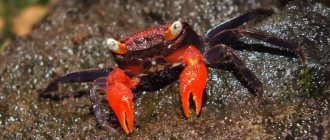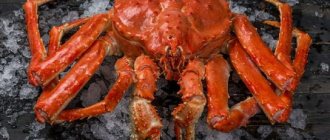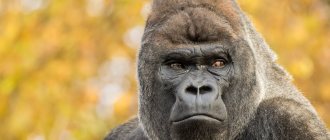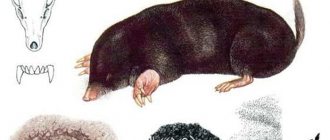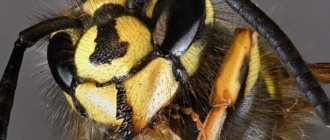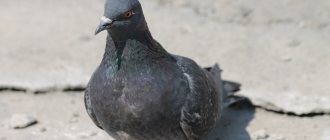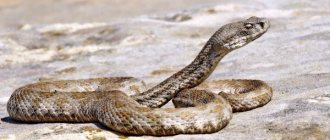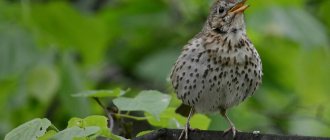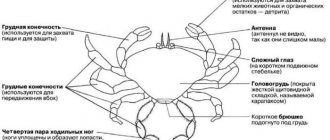Decapod crustaceans with a short abdomen are one of the favorite sea delicacies of our time. The population does not quite understand how to cut and eat crab in public, but thoughts of a luxurious restaurant dinner with this particular seafood appear constantly.
Crab meat is indeed very soft, tender and is considered a delicacy. The process of extracting meat from 5 pairs of legs and a massive shell is not so exciting. Only a few minutes of labor-intensive manipulation will bring the happy client closer to that very amazing sea taste.
But what exactly is seafood, how to eat it correctly, and how can an exotic dish be dangerous?
Kamchatka crab
Kamchatka crab (the Japanese also call it “king crab”) is considered a real delicacy. Canned products based on it are highly valued on the market and are popular all over the world. This representative is considered one of the most outstanding among crustaceans. The width of the shell of the largest individuals can reach 23 cm, the paw span is 1.5 m, and the weight is up to 7 kg.
The cephalothorax of female and male king crabs is rectangular in shape, and the shell and claws are granular. The carapace has dorsal grooves, the orbits are long, occupying the entire anterior border.
The forehead is narrow, the peduncles are slightly expanded at the level of the cornea. The antennas are movable at the base; there is a whip, the length of which is always less than the length of the orbit. The antennas are small, partially hidden under the forehead. The crab has well-opened claws with long fingers. The king crab leads a gregarious lifestyle.
Because of this, it has become an important industrial site both in America and Japan, as well as in the Russian Federation. Marine inhabitants are caught using bottom nets. During the fishing process, traps with bait are used. The body of the arthropod consists of the abdomen, cephalothorax and 10 legs. The cephalothorax, legs and belly are covered with chitin with spiked growths.
What are the differences from crayfish?
Crabs and crayfish are very similar to each other. Both arthropods belong to the class Crustaceans. The same chitinous cover, the same 4 pairs of walking legs and terrifying claws. However, if you look closely you can see how different they are.
The body of the crayfish is oblong and long. It is covered with plates and ends with a tail. The crab does not have a tail. And the body can be of different shapes.
They also differ in the way they travel. Cancer mostly moves backwards. It can walk forward, but very slowly, as its massive claws make it difficult to move.
And the crab moves sideways. And, and very quickly.
Coconut crab
The coconut crab is the largest representative among arthropods. In general, it is not considered a crab - it is a kind of hermit crab. This representative has a very frightening appearance - he can shock even a brave person who decides to explore the sea. If you have weak nerves, it is better to never see a coconut crab. The representative's claws can break even small bones.
Such individuals live on the islands of the Indian Ocean. This is especially true on Christmas Island, where large concentrations of arthropods are observed. The crab's body is divided into two parts. The first is the cephalothorax and 5 pairs of paws, and the second is the stomach.
The front legs are transformed into claws. It should be noted that the left claw is much larger in size than the right one. The next two pairs of paws have sharp ends. This allows the crab to move along inclined and vertical surfaces.
Adults use the fourth pair of legs for climbing. Its size is smaller than the other paws. With their help, the crab settles in coconut shells or mollusk shells. The last 2 legs are the weakest; the coconut crab hides them in its shell. They are used exclusively for mating or caring for offspring.
Classification [edit]
The infraorder Brachyura contains 6,793 species in 93 families,[23] more than the rest of Oesaroya. [38] The evolution of crabs is characterized by increasingly stronger bodies and smaller bellies. Although many other groups have undergone similar processes, carcinization is most advanced in crabs. The telson is no longer functional in crabs, and uropods are absent, perhaps having evolved into small devices for holding the lower abdomen tightly attached to the sternum.
Most decapods have gonopores (genital openings) on their legs. However, since crabs use the first two pairs of pleopods (abdominal appendages) to transfer sperm, this arrangement has changed. As the male abdomen became thinner, the gonopores moved toward the midline, away from the legs, and toward the sternum. [39] A similar change occurred independently with female gonopores. The movement of the female gonopore towards the sternum defines the clade Eubrachyura, and a later change in the position of the male gonopore defines Thoracotremata. It is still a matter of debate whether the monophyletic group can be formed by those crabs in which the gonopores of females, rather than males, are located on the sternum. [38]
Superfamilies[edit]
The numbers of existing and extinct (†) species are indicated in parentheses. Eocarcinus , was previously thought to be
and
Platykotta
, contains the oldest crabs; it is now considered part of Anomura. [40]
Examples of different crab sections
Ranina ranina
(Raninoida: Raninidae)
Corystes cassivelaunus
(Heterotremata: Corystidae)
Ocypode quadrata
(Thoracotremata: Ocypodidae)
Goneplax rhomboides
- Section † Callichimaeroida
† Callichimaeroidea (1 †) [41]
- †Dakoticancroida (6†)
(46, 196 †)
(99, 27 †)
- Subsection Heterotremata
Etroidea (37, 44 †)
- Cryptochiroid (46)
marble crab
The marble crab is the only inhabitant of the Black Sea that can be found on stones and coastal cliffs. This arthropod belongs to the Grapsidae family. The shell of the marine representative is shaped like a trapezoid. The size of the individual is small - from 4.5 to 6 cm. The surface of the shell is often overgrown with algae and sea acorns.
Like most crabs, marbled arthropods have 5 pairs of legs. The two front ones are powerful claws. Hair can be seen on the spider crab's walking legs. The color of the shell is blue and green or dark brown with a lot of light stripes.
The crab lives in shallow water, near stones. It can also be found in the sea at a depth of up to ten meters. This member of the crab family is able to survive without water, so it can be seen on land.
If a female or male feels danger, it either attacks or hides in the nearest shelter. During the day, the crab is located under the stones that lie at the bottom. At night he goes ashore. In the dark, the crab can climb to a height of five meters.
The crab feeds in most cases on organic remains. Like many other types of crabs living in the Black Sea, marbled arthropods are not an industrial species, but they make attractive souvenirs. In its natural habitat, the marbled crab lives from 3 to 3.5 years.
Structure
The crab seen in the photo differs from the crayfish in its structure and the way it looks. One of the significant differences is the structure of the abdomen - it is small in size and tucked under the chest. The crustacean crabs seen in the photo have 5 pairs of limbs. Of these, a pair of claws is designed to capture prey, the other 4 pairs of limbs are needed for the movement of representatives of the Crustacean family, class Higher crustaceans.
All types of crabs are found in bodies of water; respiration occurs thanks to gills. An interesting feature of the crab family is that they are not able to inhale the surrounding air while on land. They breathe the air that has accumulated in their gills.
The shell of an arthropod is its skeleton, which is located outside. It provides a protective function and also serves as support.
Interesting. During fights with enemies, this sea animal can lose its claw, as a result it gradually grows back. This explains that the size of one claw is larger than the size of the second.
The body is protected by a chitinous shell and extends into the cephalothorax. The eye sockets are located on stalk-like processes, the structure is complex, faceted, that is, inside there are a large number of eyes that send information to the brain cells. Many species of arthropods have a flat abdomen and flattened body, thanks to which they can safely hide from predators at the bottom under stones and rocky surfaces.
When molting begins, animals shed their shells and remain defenseless for a certain period. In order to protect themselves, they hide in crevices, empty shells, and holes. Adult males show aggression towards members of their own sex, this is especially evident when the breeding season begins.
The chitinous shell reliably protects marine life. But they still become prey for octopuses, sea otters, and some varieties of large fish. Fishing for crabs by people threatens their population; many of their species are included in the Red Book. To protect itself from predators, the crab animal uses camouflage. When he senses danger, his shell becomes the same color as his habitat - sand, stone. Movement occurs sideways, with the claws pointed forward.
freepik
Blue crab
This species of crab is a member of the swimming crab family. Such animals have a great industrial purpose - more than 28 thousand tons of arthropods are caught every year. Even in the century before last, its meat became a delicacy. It is for this reason that the blue crab population is rapidly declining.
The swimming crab lives on the western shores of the Atlantic Ocean, near the Cape Cod Peninsula. The latter is located in the northeast of America and reaches Argentina, as well as southern Uruguay. Most often, blue crabs can be found at the mouths of rivers and reservoirs, the depth of which does not exceed 36 meters.
Animals prefer places to live where there is silt or sand at the bottom. During the winter season, the blue crab goes deeper into the water. Adults can comfortably tolerate a drop in temperature of up to 10 degrees, while young ones can withstand temperatures from 15 to 30. The length of the shell is from 7 to 10 cm, and the width is from 16 to 20. Adult crabs can weigh about 0.4-0.95 kg. The back of a blue crab can have the following shades:
- Grey.
- Green-blue.
- Dark brown.
There are sharp spines along the entire edge of the shell, and the belly and paws are white. Males can be distinguished by their blue claws, and females by their light red claws. Marine arthropods have 5 pairs of legs.
In the process of evolution, the front paws became claws, which are used for protecting and cutting food. The last pair is similar in shape to oars - it is used for swimming. If a crab loses its limbs, it is able to restore them as quickly as possible.
Application
Crab meat is a very valuable food product. The live weight of meat occupies about 42% of the total body weight. About one and a half billion tons of crabs are caught and grown in the world every year. Raw meat is gray in color and has a jelly-like consistency. It is not eaten raw. It must first be thermally treated.
The composition contains essential amino acids and glycogen, thanks to which the meat has a pleasant sweetish taste. The meat also contains biologically active phosphorus, sulfur, and magnesium. The limbs and abdomen of the crab are eaten. There is a red film under the shell. When molting begins, this film is transformed into a new shell.
Crab meat brings great benefits to the body for various disorders in the hematopoietic system. It is recommended to use it to improve the quality of vision. This is a good prevention of heart and vascular diseases. The calorie content of meat is low, 100 g of product contains no more than 72 kcal, proteins - 18 g, fats - 0.5 g, and no carbohydrates. This is a low-calorie product that is recommended to be included in the diet menu.
Despite the benefits of seafood, it can be harmful to health. Its diet includes not only live food, but also carrion. Animal remains may contain parasites and infections. Eating contaminated meat is fraught with various complications - deterioration in the quality of vision, poisoning, disturbances in the functioning of the central nervous system. Those who suffer from allergic reactions to seafood are prohibited from eating meat.
freepik
Herbal crab
The grass crab is a relatively small but very nimble crustacean whose movement speed in some cases can reach one meter per second. A distinctive feature of the grass crab is its shell, which has a flattened, flat hexagonal shape.
These arthropods have medium-sized claws. The color of the upper part of its shell is green, the lower part can be white or yellow. Representatives of this type of crustacean can move exclusively to the side, not forward or backward.
Herbal crabs usually live on the seabed, at a depth of up to three meters. The bottom is most often hidden by pebbles or shell rock with mud, but very often they are hidden in algae thickets.
Herbal crabs feed on a wide variety of shallow water inhabitants - shrimp, mussels, small fish and crustaceans, worms, as well as organic debris. These representatives of marine fauna are nocturnal creatures. During the daytime, they rest, buried in the sea soil.
The herbal crab rightfully bears the title of “orderly of the underwater world.” These small animals prevent pollution of the sea coast by eating carrion and all kinds of organic debris on the bottom and shore.
Grass crabs prepare for mating throughout the year. The female is capable of laying up to several thousand eggs; their incubation period lasts from two to six months, depending on the time of year.
Nutrition and reproduction
The marine life is an omnivorous predator. Their menu most often includes bottom dwellers, since this is easy prey for him. The basis of the diet includes:
- invertebrates;
- sea urchins;
- crustaceans;
- shellfish;
- small fish;
- sea stars.
These marine inhabitants are dioecious. They breed in April-May. To attract a female, the male knocks his claws and performs a courtship dance. After which they touch each other with their claws and stand there for three days. Next, the male helps the female shed her shell, and they begin the mating process. At the end of mating, the male attaches a sac with spermatophores to the female’s body. The female’s body produces special enzymes that break down the membrane of the sac so that its contents can fertilize the eggs.
After fertilization, the eggs are fixed to the limbs of the animal. Their development and cultivation continues for 11 months. Cultivation of eggs occurs during the warm season. With the onset of cold weather, their development slows down. A larger number of eggs is prey for marine predators. Only a tenth of the eggs survive.
When the larvae are born, their body shape is different from the adults. The body is oblong. Movement occurs thanks to the current. After two months, the first molt occurs. After which they sink to the bottom. After three weeks, molting begins again. After each moult, the body takes on the shape and appearance that is characteristic of adults. They become sexually mature at the age of 5 years.
sand crab
This type of crab lives only on sandy bottoms. The sand crab is a good swimmer (that’s why it has the second name swimmer) and can quickly burrow into the sand (the thickened hind legs help the animal with this). Swimmers feel comfortable in cool and clean water. In such conditions, the crab can go into shallow water.
The largest specimen found on the territory of the Russian Federation lives in the Black Sea. Its length is almost 32 mm and its width is about 40 mm. The swimming crab is considered the largest among those that live in the Adriatic Sea, but due to the other abundance of other representatives of the swimming crabs, the sandy one is quite rare.
The size of the animal is very small. The individual has an oval shell measuring four centimeters in width. The legs are short, but this does not prevent the crab from moving quickly. The claws are large and look disproportionate, since the crab itself is small. The fingers are darkened, sometimes even black.
A distinctive feature of the swimming crab is the ability to swim at high speed in the water. In males, horns are observed above the eyes at the top of the stalks. When females dig a burrow, they scatter sand in all directions. The males carefully place it next to their burrows.
Links[edit]
- Sammy De Grave; N. Dean Pentcheff; Shane T. Ahen; and others. (2009). "Classification of living and fossil genera of decapod crustaceans" (PDF). Raffles Bulletin of Zoology
. Suppl 21:1–109. Archived from the original (PDF) on 06/06/2011. - Henry George Liddell; Robert Scott. "βραχύς" . Greek-English Lexicon
. Perseus Digital Library. Retrieved May 24, 2010. - Henry George Liddell; Robert Scott. "οὐρά" . Greek-English Lexicon
. Perseus Digital Library. Retrieved May 24, 2010. - F. Boselmann; P. Romano; H. Fabritius; D. Raabe; M. Epple (25 October 2007). "Composition of the exoskeleton of two crustaceans: the American lobster Homarus americanus and the edible crab Cancer pagurus
."
Thermochimica Acta
.
463
(1–2):65–68. DOI: 10.1016/j.tca.2007.07.018. - P. Chen; A.Yu. Tench; J. McKittrick; M.A. Meyers (May 2008). "Structure and mechanical properties of crab exoskeletons". Acta Biomaterialia
.
4
(3):587–596. DOI: 10.1016/j.actbio.2007.12.010. PMID 18299257. - "Japanese spider crab Macrocheira kaempferi". Oceana North America. Archived from the original on 2009-11-14. Retrieved January 2, 2009.
- Richard von Sternberg; Neil Cumberlidge (2001). "On the differences between heterotremes and thoraxes in Eubrachyura De Saint Laurent, 1980 (Decapoda: Brachyura)" (PDF). Crustaceana
.
74
(4): 321–338. CiteSeerX 10.1.1.493.6718. DOI: 10.1163/156854001300104417. - R. von Sternberg; N. Cumberlidge; J. Rodriguez (1999). "On the marine sister groups of freshwater crabs (Crustacea: Decapoda: Brachyura)". Journal of Zoological Systematics and Evolutionary Studies
.
37
: 19–38. DOI: 10.1046/j.1439-0469.1999.95092.x. - Scholz, Gerhard (November 2022). "Eocarcinus praecursor Withers, 1932 (Malacostraca, Decapoda, Meiura) - a brachyuran from the stem group". Structure and development of arthropods
.
59
: 100991. DOI: 10.1016/j.asd.2020.100991. - Carrie E. Schweitzer; Rodney M. Feldmann (2010). "The oldest brachyura (Decapoda: Homolodromioidea: Glaessneropsoidea) known to date (Jurassic)". Journal of Crustacean Biology
.
30
(2): 251–256. DOI: 10.1651/09-3231.1. - Guinot, Danièle (2019-11-14). "New hypotheses about the earliest brachyuras (Crustacea, Decapoda, Brachyura)". Geodiversitas
.
41
(1): 747. DOI: 10.5252/geodiversitas2019v41a22. ISSN 1280-9659. - Klompmaker, A. A.; Schweitzer, C.E.; Feldmann, R.M.; Kowalewski, M. (11/01/2013). "The influence of reefs on the growth of Mesozoic marine crustaceans". Geology
.
41
(11):1179–1182. DOI: 10.1130/G34768.1. ISSN 0091-7613. - LH Sweat (August 21, 2009). "Pachygrapsus transversus". Smithsonian Institution. Retrieved January 20, 2010.
- Martin J. How; Ian M. Hemmi; Jochen Zeil; Richard Peters (2008). "Claw-flapping display varies with receiver distance in fiddler crabs, Uca perplexa" (PDF). Animal behavior
.
75
(3):1015–1022. DOI: 10.1016/j.anbehav.2007.09.004. S2CID 44197123. - Guillermo Guerao; Guiomar Rotlant (2009). "Postlarval development and sexual dimorphism of the spider crab Maja brachydactyla (Brachyura: Majidae)" (PDF). Scientia Marina
.
73
(4):797–808. DOI: 10.3989/scimar.2009.73n4797. - Forward, Jr., Richard B. (1987-09-01). "Rhythms of larval release in decapod crustaceans: a review". Bulletin of Marine Sciences
.
41
(2): 165–176. - Ricardo, Gerard F.; Davis, Andrew R.; Knott, Nathan A.; Minchinton, Todd E. (2014-04-01). "Dilian and tidal cycles regulate larval dynamics in salt marshes and mangrove forests". Marine Biology
.
161
(4):769–784. DOI: 10.1007/s00227-013-2376-4. ISSN 1432-1793. S2CID 84260279. - ^ B s d e e Judith S. Weiss (2012). Walking Sideways: The Wonderful World of Crabs
. Ithaca, New York: Cornell University Press. ISBN 978-0-8014-5050-1. OCLC 794640315. - ^ a b Sally Slainis; Gerald E. Silvey (1980). "Forward Movement of the Crab." Journal of Comparative Physiology
A.
136
(4):301–312. DOI: 10.1007/BF00657350. S2CID 33455459. - A.G. Vidal-Gadea; M. D. Rinehart; J. H. Belanger (March 2008). "Skeletal adaptations for forward and sideways walking in three species of decapod crustaceans". Structure and development of arthropods
.
37
(2): 179–194. DOI: 10.1016/j.asd.2007.06.002. PMID 18089130. - "Ranina ranina's spanner crab". Fisheries and aquaculture
. New South Wales Department of Primary Industries. 2005. Retrieved January 4, 2009. - A.G. Vidal-Gadea; J. H. Belanger (2009). "Muscular anatomy of the legs of the anterior walking crab, Libinia emarginata
(Decapoda, Brachyura, Majoidea)".
Structure and development of arthropods
.
38
(3):179–194. DOI: 10.1016/j.asd.2008.12.002. PMID 19166968. - ^ abc Peter K.L. Ng, Daniel Guino and Peter J. F. Davey (2008). "Systema Brachyurorum: Part I. An Annotated List of Extant Brachyuroran Crabs of the World" (PDF). Raffles Bulletin of Zoology
.
17
: 1–286. Archived from the original (PDF) on 06/06/2011. - "Crab (animal)." Encarta. Microsoft. 2005
- Miles Kelly's Book of Life
. Great Bardfield, Essex: Miles Kelly Publishing. 2006. p. 512. ISBN 978-1-84236-715-5. - Jump up ↑
Chris MC Woods (1993).
"Natural diet of the crab Notomithrax ursus (Brachyura, Majidae) at Oaro, South Island, New Zealand". New Zealand Journal of Marine and Freshwater Research
.
27
(3): 309–315. DOI: 10.1080/00288330.1993.9516571. Archived from the original on 2008-07-08. - Robin Kennish (1996). "Diet composition influences fitness in the herbivorous crab Grapsus albolineatus
."
Oecologia
.
105
(1):22–29. Bibcode: 1996Oecol.105...22K. DOI: 10.1007/BF00328787. PMID 28307118. S2CID 24146814. - Tracy L. Buck; Greg A. Breed; Stephen S. Pennings; Margo E. Chase; Martin Zimmer; Thomas H. Carefoot (2003). "Diet selection of the omnivorous saltmarsh crab: different food types, body size, and habitat complexity." Journal of Experimental Marine Biology and Ecology
.
292
(1):103–116. DOI: 10.1016/S0022-0981(03)00146-1. - Danièle Guinot and J.-M. Bouchard (1998). "Evolution of the abdominal restraining systems of brachyuran crabs (Crustacea, Decapoda, Brachyura)". Zoosystem
.
20
(4): 613–694. Archived from the original (PDF) on November 18, 2006. - "Global catch production 1950–2004". Food and Agriculture Organization. Retrieved August 26, 2006.
- "Frequently asked questions about stone crabs". Retrieved September 23, 2012.
- Lynsey Patterson; Jamie T.A. Dick; Robert W. Elwood (January 2009). "Clawing and feeding ability in the edible crab, Cancer pagurus
: implications for fisheries practice".
Applied Science of Animal Behavior
.
116
(2):302–305. DOI: 10.1016/j.applanim.2008.08.007. - ^
Queen's University, Belfast (10 October 2007).
"Rejecting crabs can result in their death". Science Daily
. Retrieved September 21, 2012. - ↑
Daniel P. Puzo (February 14, 1985) Imitation crab attracts criticism.
Los Angeles Times - ↑
David Adam (February 8, 2005).
"Scientists say lobsters don't feel pain". The keeper
. - "Crabs 'feel and remember pain' suggests new study". CNN. March 27, 2009
- Robert W. Ellwood; Miriam Appel (2009). “Do hermit crabs have pain?” (PDF). Animal behavior
.
77
(5):1243–1246. DOI: 10.1016/j.anbehav.2009.01.028. S2CID 53197401. Archived from the original (PDF) on April 26, 2012. - ^ a b Joel W. Martin; George E. Davis (2001). Updated classification of modern crustaceans (PDF). Los Angeles County Museum of Natural History. paragraph 132.
- M. de Saint Laurent (1980). “Sur la classification et la phylogenie des Crustacés Décapodes Brachyoures. II. Heterotremata et Thoracotremata Guinot, 1977." Comptes rendus de l'Académie des Sciences
. 290: 1317–1320. - Jerome Chablais; Rodney M. Feldmann; Carrie E. Schweitzer (2011). "New Triassic Decade, Platykotta akaina, from the Arabian Shelf of the northern United Arab Emirates: earliest appearance of Anomura" (PDF). Paläontologische Zeitschrift
.
85
: 93–102. DOI: 10.1007/s12542-010-0080-у. S2CID 5612385. - Luque, J.; Feldmann, R.M.; Vernigora, O.; Schweitzer, C.E.; Cameron, C. B.; Kerr, K. A.; Vega, F.J.; Duque, A.; Strange, M.; Palmer, Arkansas; Jaramillo, C. (April 24, 2022). "Exceptional conservation of mid-Cretaceous marine arthropods and the evolution of new forms through heterochrony". Advances in Science
.
5
(4): eaav3875. Bibcode: 2019SciA…. 5.3875L. DOI: 10.1126/sciadv.aav3875. PMC 6482010. PMID 31032408. - B. B. Rossi (1969). The Crab Nebula: Ancient History and Recent Discoveries. MIT Space Research Center. CSR-P-69-27.
- Elizabeth Benson (1972). Mochica: the culture of Peru
. New York, NY: Praeger Press. ISBN 978-0-500-72001-1. - Katherine Berrin; Larco Museum (1997). The Spirit of Ancient Peru: Treasures from the Rafael Larco Herrera Archaeological Museum
. New York: Thames and Hudson. item 216. ISBN. 978-0-500-01802-6. - Kipling, Rudyard (1902). "The crab who played with the sea." Just So Stories. McMillan.
- ↑
Kalinin, Nikita;
Vershinin, Mark (2020-10-25). "Strategic analysis of the Russian crab quota auction in 2022". Maritime Policy
.
122
: 104266. DOI: 10.1016/j.marpol.2020.104266. ISSN 0308-597X.
Hairy crabs
Due to their habit of climbing into the most remote parts of underwater caves and quietly dozing there, covered with sponges, hairy crabs received a second, less official name - sleeping crabs. This species of arthropod is one of the smallest crustaceans. The dimensions of the hairy crab do not exceed 25 mm, and these representatives of crustaceans live in the coastal zone.
Sleeping crabs are stocky representatives of the order of decapod crustaceans that are found throughout the Mediterranean and North Seas. Living in the cool currents of the northeastern Atlantic Ocean, hairy crabs do not limit themselves to a specific place of residence. They are comfortable staying either at a depth of eight meters or even a hundred meters below.
The length of the hairy crab's shell is slightly more than five centimeters. The main distinguishing feature is that the shell is covered with numerous small hairs. This allows sleeping crabs to hold the sponge tightly, but not out of personal sympathy for them, but solely for camouflage. Only young sleeping crabs can “hold” sponges, and adult crabs, due to their long symbiosis with sponges, literally “grow together” with their companions.
Evolution [edit]
Reconstruction of Eocarcinus,
earliest known crab
The earliest unambiguous crab fossils are from the Early Jurassic, and the oldest, Eocarcinus,
from the Early Pliensbachian of Britain, which is likely to represent a stem group as it lacks some key morphological features that define modern crabs. [9] [10] Most Jurassic crabs are known only from their dorsal (upper half of the body) shells, making their relationships difficult to determine. [11] Crabs radiated during the Late Jurassic, consistent with an increase in reef habitat, although they would decline in the late Jurassic as a result of the decline of reef ecosystems. During the Cretaceous period, crab diversity increased, and by the end of the period they represented the dominant group of decapods. [12]
Spiny crabs
This type of crab lives in most cases in the Pacific Ocean (in its northeastern part). This animal thrives in water with a low salt content; it can even be found in freshwater bodies of water. Often fishermen take the spiny crab out of the water along with the salmon.
See this type of arthropod on the shores of Kamchatka, the Kuril Islands, and Sakhalin. This animal prefers to live on soil with a high content of stones - in shallow water, where the depth does not exceed 25 meters. It is worth noting that sometimes this crab was caught from a depth of 350 meters.
The spiny crab most often leads a sedentary lifestyle; it optimally tolerates seasonal changes in temperature conditions. The animal's shell has a large number of spines, and its width can be about 15 cm. The main diet is small mollusks.
Cultural influences[edit]
Crab fortune telling pot in Kapsiki, Northern Cameroon.
Both the constellation Cancer and the astrological sign Cancer are named after the crab and are depicted as a crab. William Parsons, 3rd Earl of Rosse, painted the Crab Nebula in 1848 and noted its resemblance to an animal; The Crab Pulsar is located at the center of the nebula. [42] The Moche people of ancient Peru worshiped nature, especially the sea, [43] and often depicted crabs in their art. [44] In Greek mythology, Karkinos was a crab who came to the aid of the Lernaean Hydra as he fought Hercules. One of the stories
Rudyard Kipling's
Just So
,
The Crab That Played with the Sea
, tells the story of a giant crab who caused the waters of the sea to rise and fall like the tides. [45] The 2022 crab quota auction in Russia is the largest revenue auction in the world, excluding spectrum auctions. [46]
In Kapsiki, the people of Northern Cameroon use path objects crab pens for fortune telling [ edit
] .
What kind of crabs can you see in an aquarium?
Crabs have long been popular pets among those who like to keep an aquarium in their home. Nowadays, such representatives of arthropods can be found in most pet stores, but they are unpretentious and take root well at home.
When choosing such a pet, you should pay attention to its size, as well as the temperature of the water where you plan to keep the crab. For example, some varieties require warm water (temperature 20-25 degrees Celsius) as well as aeration. If the animal comes from the northern regions, the water temperature should be slightly lower. There are several types of crabs that are suitable for home keeping:
- Dutch crab . The best choice for beginners, since the pet is unpretentious to its living conditions. The animal does not need dry land. It is best to keep it at a temperature of 24-25 degrees.
- Leopard crab . It received this name because of its bright and attractive color. The leopard crab will be an excellent neighbor for aquarium fish, but keeping it with frogs is not recommended. This individual also does not need to necessarily imitate sushi. It is best to keep the leopard crab at a temperature between 22 and 28 degrees.
Crustaceans (crabs) are omnivorous arthropods. In their natural habitat, they most often play the role of orderlies. Now some species are on the verge of extinction. People are to blame for these circumstances.
Benefits and harms
Thanks to its unique chemical composition, crab meat helps strengthen the heart muscle and improve the functioning of the visual organs. It is useful for anemia and cardiovascular pathologies.
Proper use of it promotes better digestibility of foods and lowers cholesterol levels in the blood. It also slows down the aging of the body, protects the nervous system from depression and anxiety.
The low calorie content of the seafood delicacy makes it a valuable product included in a range of various diets. Canned food is made from it, sold dried and boiled-frozen.
But often seafood can be fraught with great danger. Since they feed on the remains of animals, they become infected with infections and parasites. And the meat of a sick crab can cause toxic poisoning, nervous system disorders, and even loss of vision and hearing.
In order to protect your health, you need to buy crustacean meat only from trusted suppliers. Checking for compliance with the quality mark must always be supported by documentation.
People with seafood intolerance should also be careful.
Video
Reproduction at home
Crabs do not breed in captivity. This is due to the difficulty of creating conditions for reproduction and the aggressiveness of crustaceans. In the aquarium, they constantly fight for territory, food, and females.
Fights can result in self-harm and death of pets. In nature, crabs have more space, which affects their level of aggressiveness.
If conditions are as close as possible to natural during the breeding season, and the female and male have mating games, small larvae similar to plankton hatch (are born) from the eggs.
It is imperative to resettle the female with the eggs so that the larvae can go through multiple molts and grow. The water in a separate tank should be salty to prevent pathologies in the offspring. From birth to maturity, the crab molts once every 10 days.
2. There are about five thousand varieties of crabs on Earth. Outwardly, they may be completely different, but the body structure remains the same: all representatives of the order have eight legs and two claws.
3. Crabs are found almost everywhere in ocean areas. They can be seen on rocks far from the water, under the ice in Antarctica, some species can climb trees and even live in hot springs on the ocean floor.
4. Most often, crabs live in seas or oceans, at considerable depth. Some representatives go ashore, climb over rocks and sand. Crabs move sideways, on 4 pairs of limbs located in front of the abdomen.
5. Most crabs have a flat body, allowing them to squeeze into very narrow crevices. Externally, their body is covered with a dense and strong shell, which is the external skeleton of the crab. Spiders and insects have a similar exoskeleton.
Japanese spider crab
6. The largest crab in the world is the Japanese spider crab, whose dimensions reach 50 centimeters and its legspan reaches 4 meters. Large representatives of this species can weigh up to 20 kilograms. This crab is also a long-liver: its life expectancy reaches 50 years. Also, the Japanese spider crab is the oldest species of crab in the world.
7. It is believed that this species prefers to live at a depth of 200-300 meters, but there have been individuals that feel good at depths of 800 meters and above.
8. The crab's shell does not grow during its life, and when it becomes too tight, the crab simply throws it off. This molt occurs 6 or 7 times during the first year of a young crab's life, but adults usually molt only once or twice a year.
9. Some types of crabs camouflage themselves by growing sea anemones on their shells. These living decorations are excellent camouflage for the crab, and the anemone's stings are good at repelling predators.
10. Crabs lead a rather secretive lifestyle.
king crab
11. King crab (aka panther, leopard) - orange with brown spots the color of chocolate.
12. The distance between the claws of the record-breaking largest crab ever caught exceeded the height of the tallest man in the world.
13. The body of most crabs is flat, which allows them to climb even into the narrowest crevices.
14. To attract females, crabs perform intricate dances, during which they tap their claws and rattle their shells.
15. It is known that decapod crustaceans, that is, crabs, lived on Earth during the Jurassic period.
marble crab
16. The marble crab is the most terrestrial. He crawls onto land on his own and is able to remain without water for a long time.
17. Crabs can stay on land for quite a long time: the main thing is that the gills remain moist, since they, like fish, receive oxygen from water.
18. Aquarium crabs live in water and do not need dry land.
19. Crabs are very aggressive towards each other. Males often fight for the right to possess a female.
20. In a battle with other individuals or as a result of an attack by predators, crabs can lose a claw or leg, which grow back over time.
Yeti crab
21. The yeti crab is the fluffiest. Its claws have thick, light, feather-like bristles, which makes it resemble Bigfoot's yeti. He lives in the Pacific Ocean. Bristles are home to bacteria that purify the air and serve as food for it.
22. People started eating crabs in prehistoric times. Now seafood lovers around the world eat about one and a half million tons of crabs a year.
Red earth crab
23. Crab meat is rich in proteins, making it an extremely nutritious food. In addition, it contains vitamin B12 and anti-inflammatory substances.
24. Crab meat is recommended to be eaten to prevent heart disease and reduce blood pressure.
25. Crabs communicate by shaking their claws and tapping.
Species of crab Grapsus grapsus
26. One of the most common crab species is Grapsus grapsus, found along the Pacific coast. Young representatives of this species are black in color, allowing them to camouflage well among stones, while adults are multi-colored and very bright.
27. Crabs become capable of reproduction at the age of 8-10 years.
Red mangrove crab
28. Reproduction of crabs occurs like this: the male attaches his sperm covered with a water-insoluble coating to the female’s abdomen.
29.Afterwards, the female lays eggs and attaches them to the lower part of the body, under a special protective plate, where they mix with sperm and fertilization occurs.
30.After an incubation period that lasts approximately 11.5-12 months, the hatched crab larvae fall to the bottom. During the growth process, the larva molts up to 5 times.
Dutch crab
31. The Dutch crab is light brown, unpretentious, it is small, only 3 centimeters in diameter, but with very strong short claws. With their help, he buries himself in the sand.
32. There is a legend according to which crabs once made a pact with insects. The first people inhabited the water, and the second took dominion over the air.
Aquarium crab
33. The smallest crab in the world is the pea crab, whose body size reaches only a few millimeters.
34. The strongest, the hairy “strongman” crab, has yellowish bristles along its shell.
35. Also among the largest is the Kamchatka crab, which is not actually a crab.
Green grass crab
36. The fastest crab moves at a speed of 1 m/sec. It lives in the Black Sea and is called the Green Grass Crab.
37. Sea crabs are unusual creatures that have aroused human interest since ancient times. The ancient Greeks perceived them as messengers from above, something similar to the scarab beetles of the ancient Egyptians.
38. In Ancient Egypt itself, thanks to the frequent change of shell, they personified rebirth.
39. In the Inca Empire in South America, there were special beliefs - crabs live in the sky and little by little bite off part of the moon, so that it decreases thanks to them.
40. Crabs can feel pain.
Crabs on tattoos
41. The crab is a popular symbol of tattoos, the personification of mystical powers. It is done not only by those born under the sign of Cancer. It is often chosen by representatives of the maritime profession - sailors, cabin boys, boatswains.
42. Using the traditional technique, colored tattoos with a crab are made on the back, chest, and forearm. Raised claws should mean belligerence; he knows how to stand up for himself and hold the defense.
43. Eastern beliefs differ from European ones. In China, they believe that the crab portends deception; in Thailand, it is turned into a full participant in the ritual of bringing rain.
44. Buddhist beliefs attributed to them signs of posthumous reincarnation of the soul. In general, in the East, crabs were viewed favorably: they protected from the adversity of the sea elements and were signs of its favor.
45. The crab's teeth are in its stomach.
Coconut crab
46. The most carnivorous - the coconut crab - is so named because it feeds mainly on coconuts. However, it is omnivorous and feeds, among other things, on carrion. Reaches 40 centimeters in diameter. He is also a “palm thief” and can hide stolen objects, especially shiny ones, in his holes.
47. Young crabs become more or less crab-like at the age of three.
48. The shell of a crab is its external skeleton. Spiders and some types of insects have a similar body structure.
49. A crab's weight is 40% meat.
50. The palatability of crabs has made them a tasty catch in many countries, and some of their species are on the brink of extinction, partly due to the destruction of coral reefs caused by global warming.
sand crab
photo from the Internet
